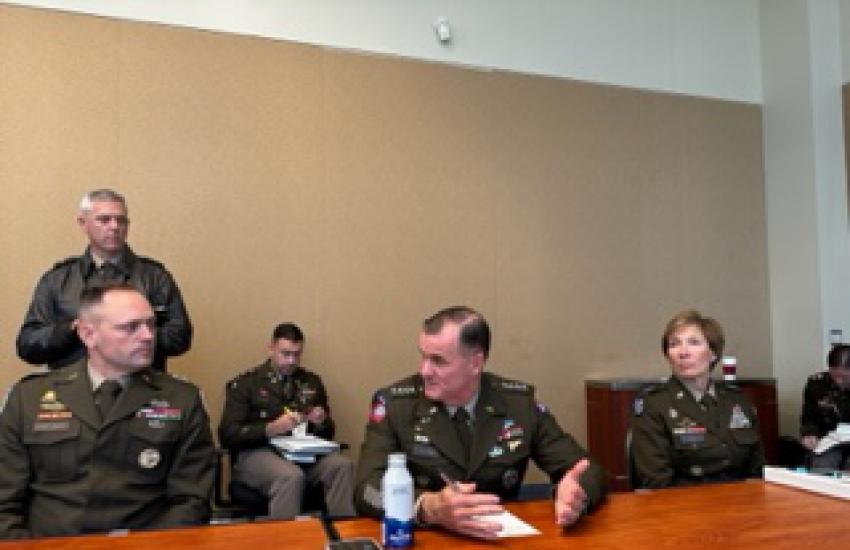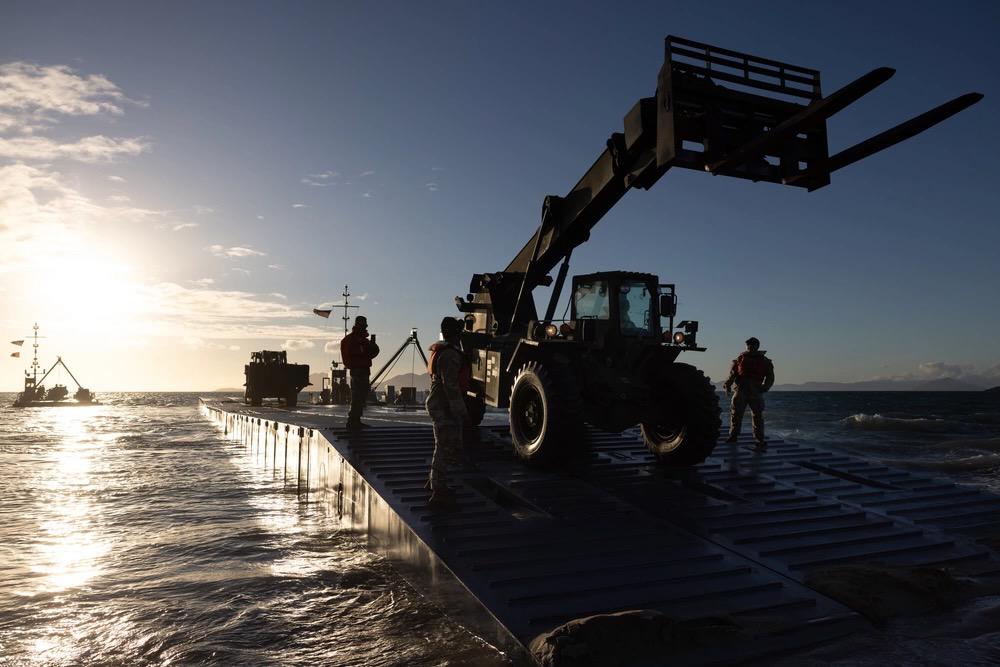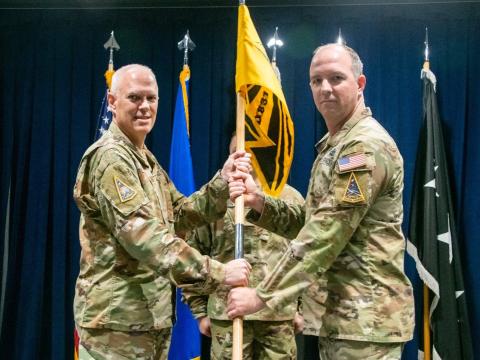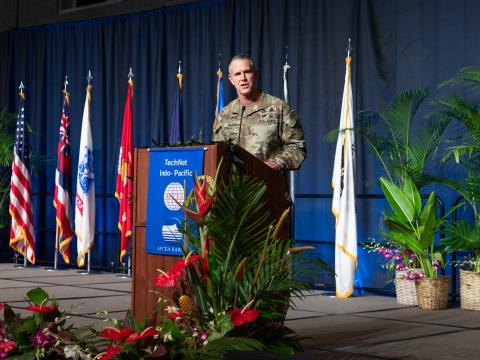Command and Control Nodes Unite the Indo-Pacific Region
U.S. Army leaders in the Indo-Pacific are calling successful the implementation of game-changing distributed command and control networks (C2) in the region that are uniting crucial operations, sustainment and medical support.
The Army’s I Corp implemented for the first time the distributed C2 communications node concept during the Talisman Sabre exercise, held in Australia from July 22 to August 4. The exercise involved 17 allies and partners, included the Five Eyes Nations (United Kingdom, Canada, New Zealand, the United States and Australia) along with France, Germany, Indonesia, Japan, Korea, Papua New Guinea, Tonga and other nations, as well as 30,000 U.S. Joint warfighters. The distributed C2 connections allowed the United States to communicate and conduct operations during the exercise connected to the joint and allied partners across the vast Indo-Pacific region.
“We’ve got a capability that I have not seen before,” said Lt. Gen. Xavier Brunson, commanding general of I Corps and Joint Base Lewis-McChord, speaking October 9 at the Association of the U.S. Army annual conference in Washington, D.C., and to reporters in a roundtable meeting with other Army leaders. “Over 32 years in the Army, I haven't seen anything like what we're doing in the Pacific right now, increasing the Army's ability to be the linchpin that our Secretary says that we are. And the key to that is our ability to communicate and communicate well.”
As part of the effort, the Army stood up the first combined joint network operations center with more than 100 U.S. soldiers, sailors, airmen, Marines, Guardians and Coast Guardsman at the center during the exercise. To enable decision-making across vast distances, the center connected to dispersed C2 nodes across the continent of Australia, Hawaii, Washington state, the Midwest the East Coast of the United States and various other allies and partners. The I Corps chief information officer and G6, Col. Rett Burroughs, led the effort, with guidance from Gen. Brunson and Gen. Charles Flynn, commanding general, U.S. Army Pacific.
“So, what Rett was able to do with some 17 nations on our network is build a mission partner environment during our exercise in Australia,” Gen. Brunson noted. “What that provides us is the ability to share amongst our partners at the right classification, which allows us to do basically sensitive but unclassified and able to push data across [to them].”
For Gen. Flynn, the sheer reach of the connected nodes was phenomenal. “If this is Perth and this is Townsville, Australia, that is like going from Los Angeles to North Carolina,” he explained. “If this is Darwin and this is Townsville, then that's like Montana to Virginia, and we had nodes in between across the continent. And I Corps had command posts, nodes all the way back on the West Coast, divisions in Alaska and in Hawaii with command posts, and we had equipment and material that was coming out of Korea and Japan, and out of the East Coast of the United States.”
The exercise itself—one of many exercises the military conducts in the Indo-Pacific—was a complex event that has greatly evolved from its past days of being an Army-to-Army exercise. “I would describe it as conducting a joint and combined rehearsal on a different piece of terrain, the Australian continent,” Gen. Flynn said. “It brought together strategic movement into the theater, then operational maneuver once in the theater, and in the theater of operations around Australia.”
The military functions included six types of operations, including amphibious operations with the Marines, aerial drops with the Air Force and various naval activities, Gen. Brunson said.
The exercise also included the Joint Theater Sustainment Command, which sustained operations from the delivery of fuels, equipment and warfighters and complex logistics through the Joint Logistics Over the Shore, Joint Petroleum Over the Shore and activities led by Maj. Gen. Jered Helwig, and the operations of the new Theater Medical Command—led by Maj. Gen. Paula Lodi—that supported both the theater sustainment and the military operations.
The dispersed C2 nodes connected these aspects as well.
“This distributed C2 network tied together with the Joint Sustainment Command was tied to Transcom [the U.S. Transportation Command], Air Mobility Command, Army Materiel Command, the Surface Deployment and Distribution Command, and the Defense Logistics Agency, pulling the Joint and [allied] logistics enterprise together,” Gen. Flynn explained. “All of this is on the other side of the planet. It should not be taken lightly our ability to keep data distributed, data forward, shared and accessible by our allies and partner in a mission partner environment, and then have the tactical ability to be able to command and control forces all the way down to company, battery troop, and then report all the way up to theater-level commands like a Joint Land Component Command or Joint Maritime Component Command.”

Furthermore, not only will those nodes remain in place, the Army leaders said, but I Corps will continue to add more dispersed C2 nodes across the Indo-Pacific, in Japan, the Philippines, Guam and other countries, providing even greater C2 connectivity.
The distributed C2 environment is part of the Army’s larger Operation Pathways effort, and it will continue to campaign in the region, organizing operations, sustainment and medical support, Gen. Brunson explained. “Within the Corps, we're talking about posture, we're talking about protection, we're talking about sustainment; those are the things that are necessary for the Army to campaign and campaign successfully in the Pacific.”
In addition, the communications infrastructure will continue to support the Army as it makes the Indo-Pacific the region of priority in the United States’ national defense. Indeed, Army land forces operating in the Indo-Pacific region, whether the soldiers are from I Corps or the 25th Infantry Division or from other units, could spend eight to 10 months in the region at a time.
“With a campaign, that implies that we can be there for a long period of time, and that implies that we come with mass, that implies that we have set objectives when we go into the region,” Gen. Brunson said. “We're not just there to go to Thailand. We're not just there to be in Bangkok. We're there because we have a friend, partner ally, and this mesh network of friends, partners and allies that help us to accomplish the things that the Army is interested in having done.”
“The security architecture that actually binds the Pacific together is land power, land forces,” Gen. Flynn emphasized. “65% of the Japanese military is army; 70% of the Philippine military is army; 80% of the Indian military is army; 70% of the Indonesian military is army; and 75% of the Thai military is army. What is problematic right now is that the Chinese are violating the territorial integrity and the national sovereignty of these countries. And the countries are pushing back. And they turn to their armies to try to help them conduct territorial defense operations.”





Comments